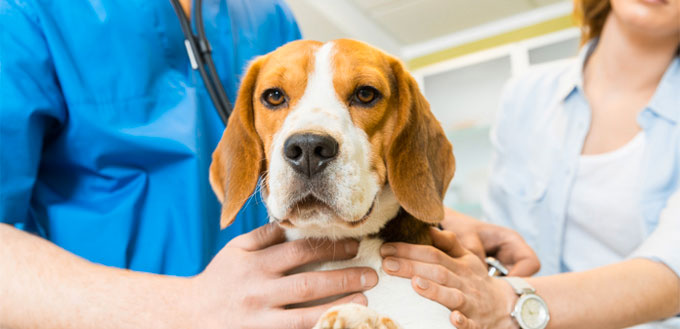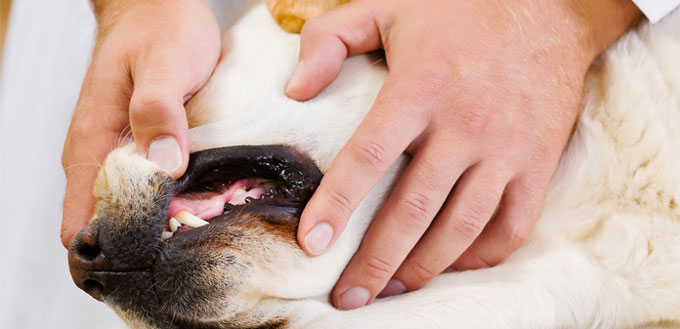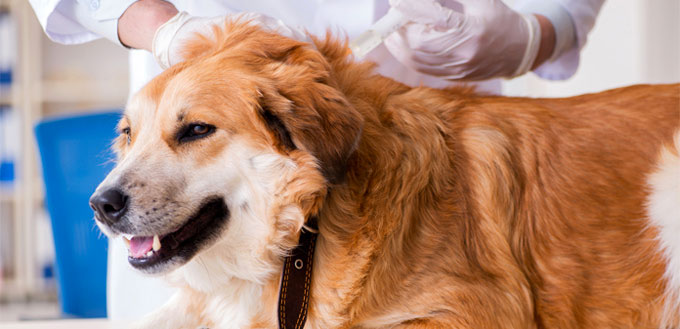We all want our dogs to have a healthy life. It can be tricky to spot dog health warning signs that indicate that something is wrong with your dog’s health. Pet owners have endless ‘when to take dog to vet’ conversations with their friends but rarely get a satisfactory answer.
Nevertheless, there are plenty of telling signs that you can look out for that will indicate that not all is well with your pet’s health. If you are currently asking ‘what is wrong with my dog’ the answers are here. Check out these 25 warning signs your dog is having a health issue that you must not ignore.

1. Breathing Difficulties
This is always a worrying warning sign and requires immediate veterinary attention. All of the possible causes of lung diseases are extremely serious. It could be a sign of a respiratory infectious disease such as a kennel cough, bronchitis or even pneumonia. There are other serious potential causes including heart failure, an allergic reaction, asthma, fluid or bleeding in the lungs or tumors.
2. Fainting
The veterinary term for fainting is ‘syncope’ and it is a complete loss of consciousness for a short period of time. A fainting dog will appear to suddenly collapse and their limbs may become stiff.
Some breeds such as Boxers, Dobermans, and Great Danes are more prone to fainting. It can be a warning sign of cardiac disease (e.g. heart arrhythmias) or neurological issues (e.g. brain or spinal cord problems).
In other dogs, it is triggered by a low concentration of glucose, calcium or sodium in the blood or by drugs such as diuretics and vasodilators. Whatever the cause, your pooch needs to be checked over by a vet.
3. Coughing or Vomiting up Blood
Bringing up blood (haematemesis) is a symptom that should never be ignored and always requires investigation by a vet.
It is important that they discover the origin of the blood. It could be the intestinal tract and that means either the mouth, the oesophagus (the tube connecting the mouth with the stomach), the stomach or the intestines. It could signal bowel disease, ulcers of the intestinal tract or ulceration of the lining of the oesophagus. Alternatively, the blood may be directly coughed up from the respiratory system (the lungs) or coughed up, swallowed and then vomited up (regurgitated). This is a sign of pulmonary disease such as tuberculosis. Kennel cough, however, tends to produce a drier cough with a honking sound.
It could be a sign or a more generalised condition such as a blood clotting disorder, head trauma, heartworm or liver failure.
4. Paralysis of Rear Limbs
This is extremely alarming and you need to get them to a vet quickly. There is a very long list of potential causes and they all need professional diagnoses and treatment. Some common causes include structural issues such as slipped discs or spinal malformation and these are more common in some dog breeds. It could be caused by injuries, genetic disorders or inflammation. Some pets become paralysed in the rear limbs after ingesting toxins or being bitten by ticks. Cancerous tumors, blood clots, and hypothyroidism will also have to be ruled out.

5. Being Excessively Thirsty
Excessive thirst in dogs is called ‘polydipsia’. If it is accompanied by abdominal tightness, it can indicate gastric torsion or bloat. Gagging and diarrhoea may also be present. Further signs are restlessness and foamy saliva. This is a serious condition when an abnormal amount of air or fluid accumulates in the stomach. There may also be a twisting of the stomach itself. It can happen to any dog but large breeds with deep chests are most prone. It is also more common in older dogs and in males. Sadly, it is a leading cause of death in dogs and veterinary attention is always required.
Polydipsia can also be a sign of kidney disease or liver disease and bladder stones or diabetes. It could even indicate an endocrine disorder so always consult your vet who will provide medical advice.
6. Lethargy
Lethargy is one of those vague symptoms that is difficult to define but usually involves a lot of sleeping and that dogs are not their regular selves in terms of their energy level. Your pal will appear lazy and refuses to move. There are several possible reasons. An infection of any kind can make your pet lethargic and it could be anything from parvovirus to heartworm disease. It could also be a sign that your pet has developed a metabolic or organic disease such as heart disease or diabetes. All of these require veterinary attention. An emergency appointment is needed if you suspect that medication or a poison is the cause of the lethargy.
There are many other possible causes including pain, a tumor or anemia and your vet can do some tests to establish the cause.
7. Difficulties Passing Urine
If you notice that your pet appears to have problems passing urine for more than a day it could indicate that their urinary tract is blocked or they may have a urinary tract infection.
Blockages can sometimes be caused by kidney disease or tumors. Your vet needs to check this out.
8. Dragging Their Butt on the Floor – Scooting
Worms are the most common reason for your dog dragging their butt along the floor. The parasites cause discomfort around the anus and your dog is trying to make themselves feel better. They may also have chronic diarrhoea and a swollen belly. The alternative explanation for your dog’s behavior is that they have fluid build-up in their anal glands. Normally these glands empty when your dog has a poop but if that doesn’t happen fluid can accumulate and this is called ‘impaction’ and causes a lot of irritation! This is more common in certain dog breeds and a vet can help with both issues.
9. Loss of Appetite
The skill here is to be able to tell a loss of appetite that indicates illness from normal fussy eating behaviour that can happen in a healthy dog. Some dogs just don’t seem to enjoy their food and the Tibetan mastiff is a prime example. They can even go days without eating a normal meal.
However, if your pet is normally enthusiastic about meal times and they have lost that enthusiasm, it should be seen as one of the warning signs that something is wrong. Start by eliminating obvious causes. Has your dog had a change of environment? Have you been travelling? Is the weather warmer than normal? If this is the case, things should settle within 24 hours.
If it lasts longer than that, it could be because the stomach or intestines are blocked. It could also be a sign of kidney, liver or heart disease. All of these need to be investigated by your vet.

10. Sudden or Unexplained Weight Loss
Sudden weight loss with no obvious physiological explanation (giving birth, feeding pups) is one of the leading warning signs of ill health and always needs to be investigated. Unexplained weight loss (even if it is not rapid) also requires investigation. Some of the potential causes are a thyroid hormonal imbalance, diabetes, parasites (including tapeworm), liver disease or dental problems.
An anxious dog will also fail to eat and this will lead to weight loss. Your veterinarian can help you discover the cause of the anxiety and do something to tackle it.
Check out our article on Anxiety Supplements for Dogs.
11. Excessive Drooling
All dogs salivate and a degree of salivation (drooling) is perfectly normal. Some breeds, such as the Newfoundland, are big droolers! However, excessive drooling in a dog that does not normally drool so much is called hypersalivation and happens when the glands produce more saliva than the dog is able to swallow. The problem can arise because an excess of saliva is being produced or because there is something wrong with the swallowing mechanism.
It could indicate that a foreign object is lodged in the mouth or it can be caused by an allergy. Alternative explanations are tumors, abscesses or poisoning. A veterinarian will be able to tell you more.
12. Gums that are Red or Swollen
When the gums are inflamed they look red and swollen and you may notice that your dog has bad breath as well. Food particles and bacteria accumulate along the gumline and form plaque. This causes irritation and the resulting inflammation is called gingivitis (gum disease) which causes bad breath and tooth loss. It is usually a sign that your dog’s dental hygiene poor!
If you are not aware of the importance of canine dental health and don’t know how to keep your dog’s mouth clean, it is time to seek some advice from your veterinarian!
13. Lameness
A lame (limping) dog is unable or unwilling to put their full weight on one or more limbs. It is always a sign that something is wrong and will often need treatment by a veterinarian. If it is something as simple as overuse, it will resolve itself within a day. If it goes on longer, it probably has another cause.
Pet owners should look for some other visible clues. Is there an object protruding out from their paw? Is a toe-nail curling over or is there a visible cut or insect bite? There are other potential causes such as hip dysplasia, a degenerative joint disease (arthritis) or even cancer.
14. Avoiding Touch
Most dogs love human attention! They like nothing more than being fussed over and stroked or scratched by their owners. Has your dog stopped rolling over for their usual belly rub? It is almost certainly a sign of illness that requires attention.
One common reason for sensitivity to touch in the abdominal area is bloat and gastric torsion or inflammation. These are very serious and require immediate veterinary attention.
15. Lumps and Bumps
There are three main explanations for lumps and bumps in dogs. The first is fat pockets which are large benign tumors (called lipoma). They are usually soft and movable under the skin. One dog could have several of them but each one needs to be checked over by a veterinarian.
The second possibility is a cancerous tumor and these tend to be more common in older dogs. Finally, it could be a foreign body such as Foxtail weeds that have triggered a reaction.

16. Severe Vomiting
It is not unusual for a dog to vomit! Something may have disagreed with them or they may have gobbled down their food too fast. However, repetitive and prolonged vomiting is one of the warning signs that something is wrong. Where a dog is vomiting more than once in a day or where it is accompanied by diarrhoea, lethargy, blood in the poop or dehydration you must see a veterinarian right away.
There are a huge number of potential causes and only a veterinarian will be able to make an accurate diagnosis. It could be anything from a bacterial infection of the gastrointestinal tract or an intestinal parasite to pancreatitis or an infected uterus which are serious health issues.
17. Changes in the Coat
The condition of a dog’s coat can tell you a lot about their health and well-being. A thick glossy coat is a sign of a happy and healthy pooch. Conversely, a thinning coat that is rough and has lost its lustre is a sign that not all is well. Whilst it may not require an emergency appointment at the vet, it does require some investigation and a trip to the vet if you can’t get to the bottom of it yourself.
The poor hair coat is characterised by a lack of coat lustre and a dry, brittle feel. It could be caused by a poor diet, hypothyroidism (low levels of thyroid hormones) or diabetes.
Hair loss all over the body can indicate a weakened immune system and further infections can follow. Mange is caused by mites and often accompanied by redness and pustules. Ringworm is a fungal infection that causes patchy hair loss. Various allergies can cause hair loss as well as itchy or scaly skin and redness. Cushing’s disease (an increase of corticosteroids in the body) can cause hair loss with bruising and lethargy.
Discrete bald spots can have an alternative cause. They could be caused by exposure to toxins or contact dermatitis or by calluses. There could be a physical cause such as chronic pressure or they could be a vaccine or medication reaction as well as excessive licking.
18. Fever
The normal body temperature for dogs is between 101 and 102.5 degrees Fahrenheit and anything over this signifies illness. Telltale signs of fever in a dog include lethargy and seeming depressed. They may also shiver, have no appetite and may vomit.
The only way to be certain that they have a fever is to take their rectal temperature with a specially designed dog thermometer. If you are an experienced and skilled dog owner, you could do this yourself using some water-based lubricant. You may feel happier for a veterinarian to do this as they will know how to carry out the test quickly and cause the least amount of discomfort to your dog. They can also accurately interpret the results and give advice.
19. Gum Discolouration – Pale, White, Blue, Yellow
This is often a sign of shock, internal bleeding, liver disease or circulatory problems. You need to get your dog to a veterinarian as soon as possible. When gums are yellow it is usually caused by a high concentration of bilirubin (a bile pigment) and indicates a problem with the liver.
20. Sneezing and Snorting that is Constant and Repetitive
Persistent sneezing and snorting are so similar in dogs that they are almost the same thing! A sudden bout of constant sneezing/snorting and a runny nose means that something has irritated the mucous membranes of their nose. It could be dust, perfumes, carpet powders or pollen.
In extreme cases it could be a plant called Foxtail. It produces tiny barbs that attach to the inside of the nose and can even get inside the body and travel to other organs. This is no laughing matter and can turn into a medical emergency so they need to be removed by a veterinarian immediately. You may also notice that your pooch squints their eyes, paws at their eyes and shakes their head from side to side.
21. Seizures
If your usually boisterous pooch becomes unsteady and confused and then flops to the floor and appears to be treading water, it is likely that they are having a seizure. It can happen to any breed at any age and it is very distressing for an owner to see. All seizures require veterinary attention. However, if your dog has a seizure that lasts more than five minutes or has several in a row, you need to get them to a vet very fast.
In pups, bacterial and viral infections can cause seizures but in adolescent dogs and young adults, it could mean that they have epilepsy. In older dogs, it can be a sign of a brain tumor, encephalitis (brain inflammation) or liver or kidney disease which can lead to kidney failure.

22. Over-heating
Canine over-heating can become life-threatening as it leads to heat exhaustion and heat stroke. Sadly, both can result in sudden death from cardiac arrhythmias without immediate treatment.
How do you know that your dog is over-heating? They will have rapid breathing and this will be followed by disorientation with a fast, noisy breathing pattern that seems like labored breathing. Other symptoms include collapse, convulsions, bright red or blue gums and vomiting.
Any dog can overheat and leaving them in a vehicle is the biggest risk factor. This is something you should never do. Field dogs are especially vulnerable to over-heating because they have an irresistible urge to carry on retrieving even when they are dangerously hot. It is up to you as their owner to recognise the signs and cool them down with water as you transport them immediately to a vet.
23. Abdominal Enlargement or Swelling
Many causes of abdominal enlargement in dogs are potentially life-threatening so you need to see a veterinarian immediately. It could be caused by gastric dilatation and volvulus (GDV) which is also called bloat which is likely to require surgery and should be treated immediately.
It could also be caused by peritonitis which is an infection of the membrane covering the intestines. This could mean that your dog’s intestine has been punctured by bone splinters, ulcers or a tumor.
It could be an accumulation of blood because of internal bleeding or by the accumulation of fluid in the abdomen (ascites). This can originate from heart failure, liver disease or even kidney problems.
24. Excessive Scratching and Hair Loss
This is one that you could investigate yourself as the most likely cause is fleas. If the scratching is accompanied by droppings or “flea dirt” in their coat, flea eggs in the dog’s environment (dog blanket or bed) and scabs then it is time to start flea treatment. It could also be an allergic reaction to food so a change in diet may help.
More serious problems associated with itchy skin and dry skin that require a trip to the veterinarian include mange and dermatitis.
25. Allergic Reactions
Dogs do not get as many allergic reactions as cats but they can react badly to some things in the environment or in their diet (corn and gluten are the most likely culprits). Heartworms can also trigger an allergic reaction.
You may be able to spot what has caused the reaction if it follows a vaccination, a change in diet, a flea infestation.

Should I Take my Dog to the Vet?
It’s clear that some of the 25 warning signs can wait a day or so whilst you observe if they have got better by themselves. Others (such as flea infestation) can be treated successfully at home.
It is also important that you stay alert for any of the more serious health issues that could indicate that something is seriously wrong and get it checked out right away by a veterinarian. If your dog shows any other signs of being different from their usual, lovely selves, for more than a day or so, it is always worth getting it checked out.
Sources:
- Lisa Maciorakowski, DVM, Pet Care for Older Animals, The MSPCA–Angell
- Common Dog Diseases, The ASPCA
- Canine Idiopathic Epilepsy, Veterinary Health Center – University of Missouri
- Difficulty Breathing (dyspnea), Tufts University
- Vomiting Pets, Washington State University – College of Veterinary Medicine
- Fainting, Tufts University
- Fatty Skin Tumors in Dogs, PetMD
- 6 Most Common Dog Health Problems, WebMD
- 7 Warning Signs Your Dog Might Be Sick, VetStree
- Ryan Llera, BSc, DVM, Emergencies in Dogs, VCA Hospitals
Leave a reply
Note: The advice provided in this post is intended for informational purposes and does not constitute medical advice regarding pets. For an accurate diagnosis of your pet's condition, please make an appointment with your vet.







I had no idea that if a dog suddenly loses their appetite and evades your touch are clear signs that something is wrong with their abdominal area. My friend told me that his beagle is acting like this lately, and his dog is someone who likes to be rubbed on their tummy. I’ll share this with him and suggest that he take his dog to a veterinary clinic for proper diagnosis.